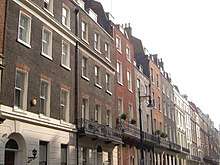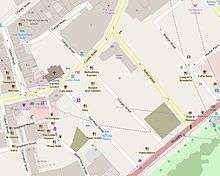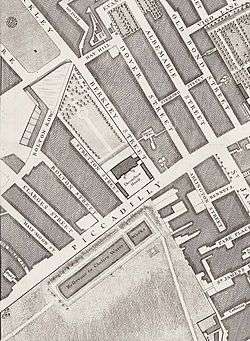Bolton Street, London
Bolton Street is a street in the City of Westminster, London. The street runs from Curzon Street in the north to Piccadilly in the south.

Bolton Street
History

The immediate vicinity of Bolton Street

Bolton Street on John Rocque's 1746 map of London
Bolton Street was built in around 1696. It was named after the Duke of Bolton, who had a nearby residence. In 1708, Bolton Street was the westernmost street in London.[1]
Notable inhabitants
_brown_plaque.jpg)
Madame D’Arblay (Fanny Burney) brown plaque
Famous former residents of Bolton Street include:
- Madame D'Arblay (pseudonym Fanny Burney), playwright, at No. 11. Her former residence is marked by a brown plaque erected by the Society of Arts;
- Richard Clement (1754 - 1829), sugar plantation owner of Barbados, at No. 13[2]
- Colonel Thomas Moody, Kt., City of London merchant and Colonial Office officer, at No. 23;[3][4][5][6]
- Henry James, novelist, at No. 3.;[1]
- John Pitt Dening, soldier and polo player, who shot himself at the Bolton House Hotel in the street in 1929.[7]
Buildings
The western side of the street has been almost completely replaced by modern buildings but the eastern side still contains many Georgian buildings. Among the listed buildings in the street are numbers 11,[8] 13,[9] 14,[10] 15,[11] 16,[12] 17 and 18,[13] 19 and 20.[14]
gollark: Have you tried making it be up?
gollark: Your thing probably just gained sentience and started harvesting local computing power or something.
gollark: Pick arbitrary cool-looking regression lines going through it.
gollark: What if you make a mechanical computer out of several thousand spines?
gollark: Wow, I guess none can escape.
References
- "Bolton Street, W1." in Christopher Hibbert; Ben Weinreb; John Keay; Julia Keay (2010). The London Encyclopaedia. London: Pan Macmillan. p. 81. ISBN 978-0-230-73878-2.
- "Richard Clement: Profile and Legacies Summary, Legacies of British Slave Ownership, UCL". University College London. 2019.
- Incorporated Society for the Conversion and Religious Instruction and Education of the Negro Slaves in the British West India Islands (1828). "Report of the Incorporated Society for the Conversion and Religious Instruction and Education of the Negro Slaves in the British West India Islands for the Year 1828". R. Gilbert. p. 236.
- Incorporated Society for the Conversion and Religious Instruction and Education of the Negro Slaves in the British West India Islands (1829). "Report of the Incorporated Society for the Conversion and Religious Instruction and Education of the Negro Slaves in the British West India Islands for the Year 1829". William Clowes, London. p. 88.
- Eliza Boyle & Son (1829). "Boyle's Fashionable Court and Country Guide, January 1829". Eliza Boyle & Son, 284 Regent Street, London. p. 436.
- Thomas Moody (1779 - 1849) (1828). "Letter of Thomas Moody, late Commissioner for inquiring into the State of Captured Negroes, 7 July 1828, in Papers Relating to the Slave Trade, of the Session 29 January - 28 July 1828, Vol. XXVI". House of Commons.
- "International Polo Player Found Shot", The Times, 10 April 1929, p. 18.
- Historic England. "Details from listed building database (1066426)". National Heritage List for England. Retrieved 2 October 2015.
- Historic England. "Details from listed building database (1357209)". National Heritage List for England. Retrieved 2 October 2015.
- Historic England. "Details from listed building database (1066427)". National Heritage List for England. Retrieved 2 October 2015.
- Historic England. "Details from listed building database (1219165)". National Heritage List for England. Retrieved 2 October 2015.
- Historic England. "Details from listed building database (1219171)". National Heritage List for England. Retrieved 2 October 2015.
- Historic England. "Details from listed building database (1357210)". National Heritage List for England. Retrieved 2 October 2015.
- Historic England. "Details from listed building database (1219182)". National Heritage List for England. Retrieved 2 October 2015.
External links
![]()
This article is issued from Wikipedia. The text is licensed under Creative Commons - Attribution - Sharealike. Additional terms may apply for the media files.